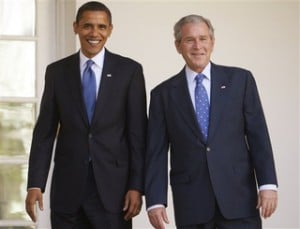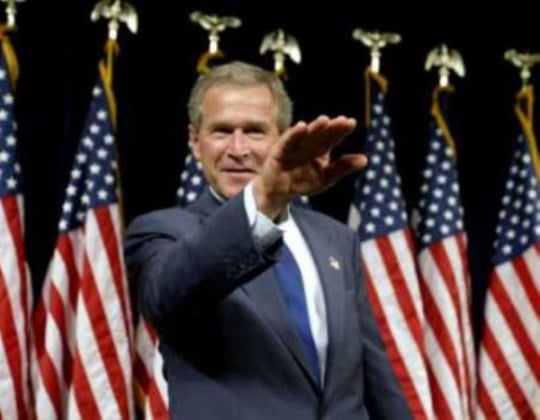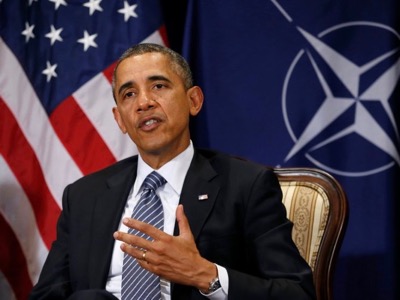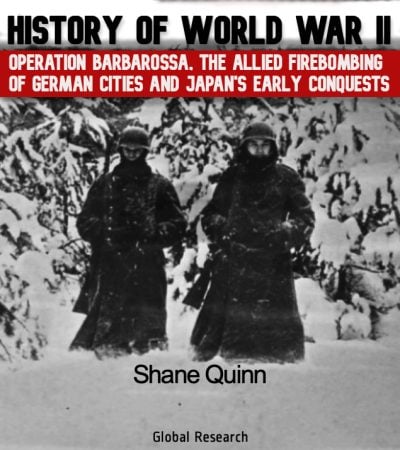The Bush and Obama Administrations, a Continuation of Policy? Russia and China Hemmed in Close to Their Borders

All Global Research articles can be read in 51 languages by activating the “Translate Website” drop down menu on the top banner of our home page (Desktop version).
To receive Global Research’s Daily Newsletter (selected articles), click here.
Visit and follow us on Instagram, Twitter and Facebook. Feel free to repost and share widely Global Research articles.
***
Introduction. The Presidency of George W. Bush (2001-2009)
During president George W. Bush’s two terms in office (2001-2009), his administration’s policies typically favoured America’s richest, and whose wealth had already increased greatly since the early 1980s under neoliberal policies.
The Bush administration reduced taxes without clear justification, while many ordinary American families could no longer guarantee a college education for their children. The latter were left with the option of enlisting in the US Armed Forces, in order to receive education benefits.
Inequality and poverty were rising sharply in the world’s most powerful state. By 2007, 34.6% of private wealth in America was concentrated in the hands of 1% of the country’s society, the ultra elite. Near the end of Bush’s presidency, the top 20% of earners in America had accumulated 85% of the nation’s wealth. By 2010 there were around 48 million Americans unemployed among those aged between 17 and 64.
Bush’s White House dispatched billions of taxpayer dollars to fund the social services of often extremely conservative, faith based organisations (Catholic and evangelical Protestantism, both forms of Christianity). The political goal of these groups was to erode American democracy and to establish a theocratic state; that is a nation in which religious figures rule in God’s name.
The evangelicals further wish to amend the constitution, by claiming that the US is a Christian country. Less than two-thirds of Americans, 63%, now identify themselves as believers in Christianity. White evangelical protestants consist of a modest 14.5% of the American population, and the percentage is dropping.
two-thirds of Americans, 63%, now identify themselves as believers in Christianity. White evangelical protestants consist of a modest 14.5% of the American population, and the percentage is dropping.
Nevertheless, in the first decade of this century the evangelicals controlled more than 60 religious organisations. In just one year (2004) evangelical groups received $2 billion in donations from the Bush administration, and they have viewed Bush as one of their own, not without reason. Bush is a very religious man and, as the president reportedly said in July 2003, he is “driven with a mission from God”.
Karl Rove, the political consultant who influenced Bush’s victorious 2000 and 2004 election campaigns, believed success depended on the white evangelical vote. A massive 78% of Americans from this ethnicity group voted for Bush in November 2004, having risen from 68% four years before.
Conservative to far-right evangelicals have, in fact, been gradually gaining influence in America since the 1960s, particularly within the Republican Party. The evangelicals enjoy increased involvement in social areas, relating to the perceived persecution of religious schools, along with their views on the place of men and women in society, and also on marriage, divorce, homosexuality and abortion. Patrick J. Buchanan, the American political commentator, went so far as to say that a “cultural war” within America was “as critical to the kind of nation we shall be as the Cold War itself” because the cultural war “is for the soul of America”.
Despite growing support from Christian groups like the evangelicals, Bush’s overall popularity in America was declining as the years flicked by. In the days after the 9/11 atrocities against America in September 2001, Bush’s approval ratings stood at between 86% to 90%. By November 2008 it had plummeted to 25%. A poll from May 2008, conducted by CNN/Opinion Research Corp., revealed that 71% of Americans disapproved of how Bush was running the country, and that he was the most “unpopular president in modern American history”.
The Bush-Obama Transition. Obama Served the Interests of “Big Money”
Harvard University professor Lawrence Katz said “this is truly a lost decade [2000-2009]”. It was also a lost decade in the military sphere, regarding defeats on the ground. When the Bush presidency was coming to a close in 2008, he was no longer speaking of “victory” or “winning” in Iraq, with US military forces having failed to subdue and control the country.
The US Congressional Budgeting Office estimated the long-term price of the war in Iraq could reach up to $4.5 trillion. Much of the colossal spending has been at the expense of the American taxpayer. In August 2021, it was calculated too that Washington had spent at least $2.3 trillion on military operations chiefly in Afghanistan, after a 20 year war in that country. The $2.3 trillion estimate includes money spent on US military actions in Pakistan, which shares a 1,640 mile border with Afghanistan.
America has traditionally been led by white Anglo-Saxon protestants (WASP), those usually belonging to the ruling classes who had long overseen the US financial system. The assumption to power in January 2009 of an African-American leader, Barack Obama, was a symptom of the decline of white America. It perhaps seemed to constitute a setback to the Anglo-Saxon governing elite.
However, the American historian Noam Chomsky pointed out on 20 June 2013,
“I really didn’t expect very much from Obama. I wrote critically about him even before the primaries, just quoting his website. It was pretty clear that his campaign was smoke and mirrors”.
 President Obama continued to serve the centres of power, in some ways at least. Even before his inauguration in early 2009, Obama proposed another trillion dollar bailout for the major banks. Who were among those that had funded Obama’s all important election campaign from 2007-2008? He received $1,034,615 from Goldman Sachs, a leading American investment bank. Goldman Sachs dispensed with only $234,595 to the candidacy of Obama’s challenger, John McCain.
President Obama continued to serve the centres of power, in some ways at least. Even before his inauguration in early 2009, Obama proposed another trillion dollar bailout for the major banks. Who were among those that had funded Obama’s all important election campaign from 2007-2008? He received $1,034,615 from Goldman Sachs, a leading American investment bank. Goldman Sachs dispensed with only $234,595 to the candidacy of Obama’s challenger, John McCain.
Another powerful investment bank, JPMorgan Chase & Co., donated $847,895 to Obama. McCain received a mere $336,605 from JPMorgan Chase & Co. Citigroup Inc., yet another large American bank, furnished Obama’s campaign with $755,057, while the same corporation gave McCain’s campaign $330,502. Obama also received a donation of $817,855 from Google, among many others.
Obama’s campaign raised more than 3 times as much cash from bankers and financial corporations, in comparison to that of McCain. Moreover, Obama’s election chances were bolstered by cash injections from institutions like the University of California which forked out $1,799,460, and Harvard University, $900,909. Apparently these educational centres see no conflict of interest in bankrolling presidential elections.
Bush’s performance, a Republican president, with his reputation harmed further during the financial crisis of 2007-08, had convinced the Wall Street business executives that a Democratic Party candidate (Obama) would be a safer bet than a Republican Party candidate (McCain). Obama’s campaign was engineered by crafty and relentless propaganda, “public relations” in modern parlance, which proved more effective when compared to his Republican rival.
A year into Obama’s presidency the US State Department recognised, in a report it compiled in the first 4 months of 2010, that there were at least 36 active conflicts smouldering across the globe; and that the risk of war was increasing worldwide, especially in poor countries where corruption reigned, access to weapons financing was easy, and in which instability was severe in neighbouring states. The conflicts were spreading especially in the Middle East, the Caucasus and Africa.
What the US State Department did not mention, was that Washington had a very considerable role in fanning the flames of war. Brazilian scholar Moniz Bandeira observed how in November 2014, “Russia’s Deputy Minister of Defense, Anatoly Antonov, rightly accused the United States of being responsible for two-thirds of the military conflicts that flared up in the last decades, including those in Yugoslavia, Iraq, Afghanistan and Syria, by taking advantage of economic and social difficulties, in addition to various ethnic and religious conflicts, intervening under the pretext of expanding democracy”.
Obama’s Neoconservative Foreign Policy. Encirclement of Russia and China
During Obama’s two-term presidency (2009-2017), US foreign policy was based to an extent on the neoconservative doctrines of the Bush White House; but it can be pointed out, Obama was not as aggressive as his predecessor. Only 2 European states joined NATO during the Obama era, Croatia and Albania in April 2009, and the groundwork for that was laid by Bush. In comparison, 7 European countries joined NATO during Bush’s tenure, but one could argue the real number was 9 with Albania and Croatia.
Obama did continue large-scale attempts to encircle Russia and China, while expanding Washington’s international drone assassination campaign. The Obama administration “had brokered a deal to transition power in Ukraine” in February 2014, according to the president himself on CNN the following year. This was a virtual admission of an American-backed putsch in Kiev. Geopolitical analyst George Friedman said “it truly was the most blatant coup in history” which installed a Western-friendly regime in Kiev, and that Russia “wants a Ukraine that is neutral”.
Relating to China, Obama set out clearly, in January 2012, a new strategic plan through which the US would confront China’s growing power. On 5 January 2012 Obama stressed at the Pentagon, “We will be strengthening our presence in the Asia Pacific, and budget reductions will not come at the expense of that critical region”. Strengthen it he did, by enhancing the US military to hem China in close to its frontiers, with US naval and army bases, warships, bombers and submarines.
We can take note that much of the American military presence is ensconced around the waters in China’s sphere of interest. In mid-May 2020 a 500 foot long American destroyer, the USS Rafael Peralta, was spotted sailing in the Yellow Sea 116 nautical miles from the coast of Shanghai, China’s most populous city.
The previous month on 17 April 2020 another formidable US destroyer, the USS McCampbell, was seen in the Yellow Sea just 42 nautical miles from the Chinese city of Weihai. The US continues to hold a major strategic advantage over its adversaries, the fruits of which were secured mostly in the Second World War. US military officials speak regularly of conducting “freedom of navigation” operations in the South China Sea, which the Americans regard as “international waters”. The Chinese and Russians are not quite afforded the luxury of conducting “freedom of navigation” exercises in the Caribbean Sea or Gulf of Mexico, near American shores.
In June 2015 president Obama approved the American National Military Strategy (2015 NMS). This singled out Russia, China, Iran and North Korea as the countries that are most strategically challenging to US hegemony. Yet the National Military Strategy made the rather glaring concession that “none of these nations are believed to be seeking direct military conflict with the United States or our allies”.
*
Note to readers: Please click the share buttons above or below. Follow us on Instagram, Twitter and Facebook. Feel free to repost and share widely Global Research articles.
Shane Quinn, Journalist and renowned Historian, focussing on geopolitics and the history of World War II, based in Ireland. He is a Research Associate of the Centre for Research on Globalization (CRG).
Sources
Jo Adetunji, “Understanding evangelicalism in America today”, The Conversation, 4 August 2021
“Religion plays big role in Bush presidency”, ABC News, 21 May 2001
Noam Chomsky, Global Discontents: Conversations on the Rising Threats to Democracy, with David Barsamian (Hamish Hamilton; 1st edition, 5 Dec. 2017)
Luiz Alberto Moniz Bandeira, The Second Cold War: Geopolitics and the Strategic Dimensions of the USA (Springer 1st ed., 23 June 2017)
Patrick J. Buchanan, “Address to the Republican National Convention”, American Rhetoric Online Speech Bank, 17 August 1992
Paul Steinhauser, “Poll: More disapprove of Bush than any other president”, CNN, 1 May 2008
RT, “US responsible for two-thirds of all military conflicts – Russia’s top brass”, 27 November 2014
Elena Chernenko, Alexander Gabuev, “‘In Ukraine US interests are incompatible with the interests of the Russian Federation’, Stratfor chief George Friedman on the roots of the Ukraine crisis”, US-Russia.org, 17 January 2015
Luiz Alberto Moniz Bandeira, The World Disorder: US Hegemony, Proxy Wars, Terrorism and Humanitarian Catastrophes (Springer; 1st ed., 4 Feb. 2019)
Watson Institute for International and Public Affairs, Costs of War, August 2021
“President Bush Participates in Signing Ceremony with NATO Secretary General De Hoop Scheffer for NATO Accession Protocols for Albania and Croatia”, Bush White House Archives, 24 October 2008
TeleSUR, “Ukraine One Year On From The President’s Ousting”, 22 February 2015
Matt Compton, “President Obama Outlines a New Global Military Strategy”, Obama White House Archives, 5 January 2012
Kristin Huang, “US destroyer spotted off coast of Shanghai as PLA Navy begins 11-week exercise in Yellow Sea”, South China Morning Post, 15 May 2020
 History of World War II: Operation Barbarossa, the Allied Firebombing of German Cities and Japan’s Early Conquests
History of World War II: Operation Barbarossa, the Allied Firebombing of German Cities and Japan’s Early Conquests
By Shane Quinn
The first two chapters focus on German preparations as they geared up to launch their 1941 invasion of the Soviet Union, called Operation Barbarossa, which began eight decades ago. It was named after King Frederick Barbarossa, a Prussian emperor who in the 12th century had waged war against the Slavic peoples. Analysed also in the opening two chapters are the Soviet Union’s preparations for a conflict with Nazi Germany.
The remaining chapters focus for the large part on the fighting itself, as the Nazis and their Axis allies, the Romanians and Finns at first, swarmed across Soviet frontiers in the early hours of 22 June 1941. The German-led invasion of the USSR was the largest military offensive in history, consisting of almost four million invading troops. Its outcome would decide whether the post-World War II landscape comprised of an American-German dominated globe, or an American-Soviet dominated globe. The Nazi-Soviet war was, as a consequence, a crucial event in modern history and its result was felt for decades afterward and, indeed, to the present day.
Click here to read the e-Book.

